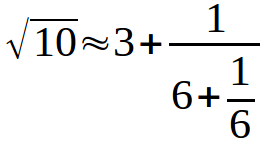Algorithm
Problem Name: beecrowd | 2161
Problem Link: https://www.beecrowd.com.br/judge/en/problems/view/2161
Square Root of 10
By M.C. Pinto, UNILA  Brazil
Brazil
Timelimit: 1
The method of periodic continued fractions is one of the many ways to calculate the square root of a natural number. This method uses as denominator a repetition for fractions. This repetition can be done by a fixed number of times.
For example, by repeating 2 times the continued fraction to calculate the square root of 10, we have the following equation.

Your task is to calculate the approximate value of square root of 10 given the number N of repetitions.
Input
The input is a natural number N (0 ≤ N ≤ 100) that indicates the quantity of denominator repetitions in the continued fraction.
Output
The output is the approximate value of the square root with 10 decimal places.
| Input Samples | Output Samples |
|
0 |
3.0000000000 |
|
1 |
3.1666666667 |
|
5 |
3.1622776623 |
Code Examples
#1 Code Example with C Programming
Code -
C Programming
#include <stdio.h>
int main(void)
{
int n;
double ans=0.0;
scanf("%i", &n);
while(n)
{
ans+=6.0;
ans=1.0/ans;
--n;
}
ans+=3.0;
printf("%.10lf\n", ans);
return 0;
}
Output
#2 Code Example with C++ Programming
Code -
C++ Programming
#include <bits/stdc++.h>
using namespace std;
int main()
{
int n;
double calc = 0;
cin >> n;
while(n--){
calc+=6;
calc = 1/calc;
}
cout << fixed << setprecision(10) << 3+calc << endl;
return 0;
}
Output
#3 Code Example with Javascript Programming
Code -
Javascript Programming
start coding...Output
#4 Code Example with Python Programming
Code -
Python Programming
def r10(n):
if n == 0:
return 6
x = 6+1/r10(n-1)
return x
n = int(input())
x = r10(n)-3
print('%.10f' % x)
Output
